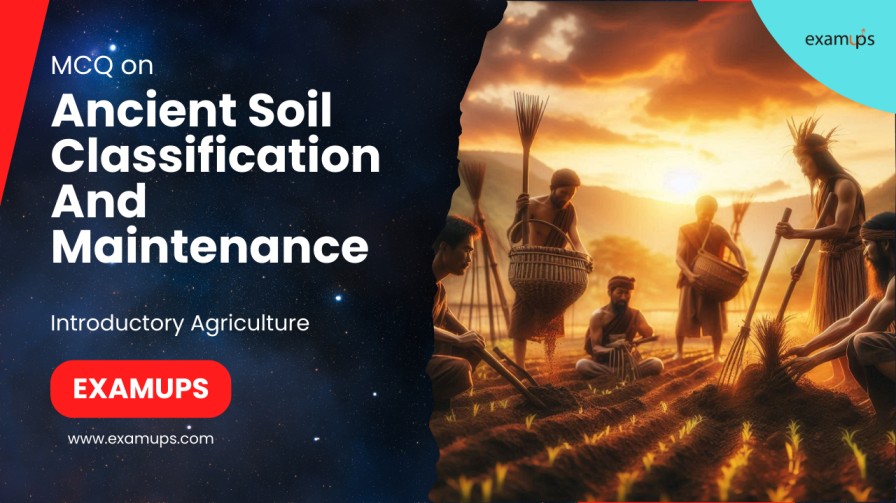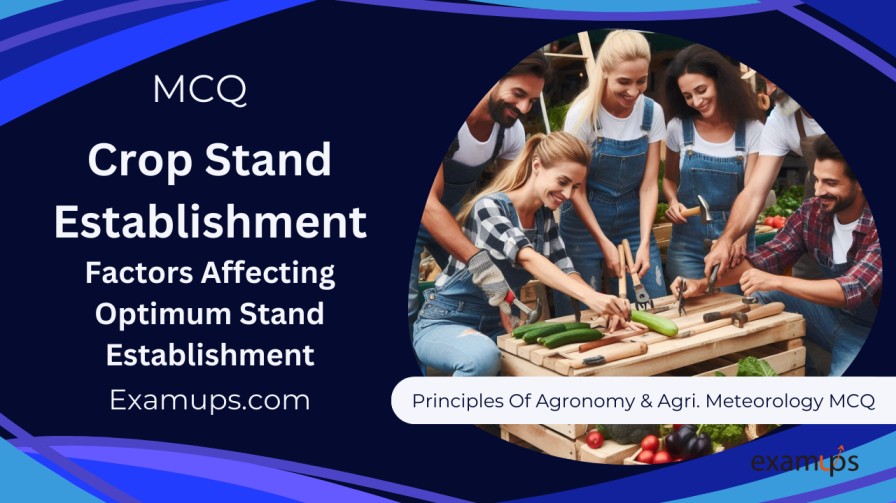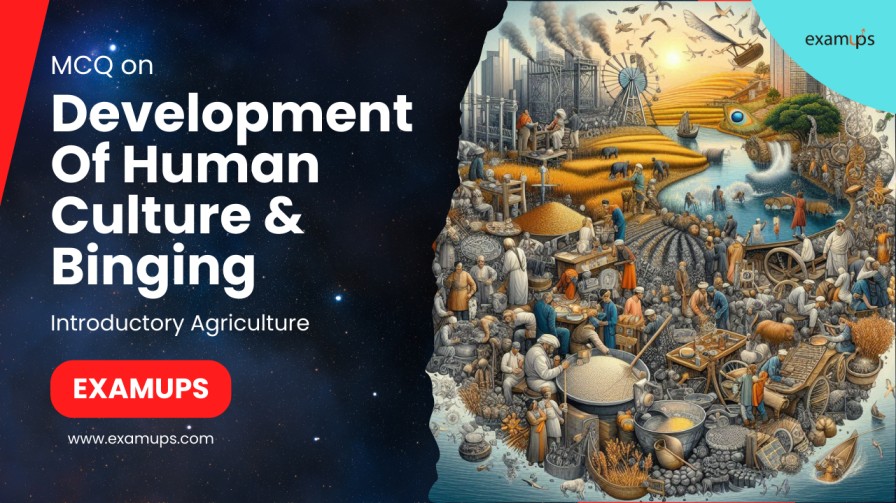Ancient Soil Classification And Maintenance MCQ for ICAR-JEF, ICAR-SRF, ICAR-NET, IBPS-AFO/SO, Pre-PG, BHU Pre-PG, IFFCO-AGT, CCI, FCI, B.sc, M.sc, All Agriculture Competitive Exams.
1. What are the three primary geographical classifications of soil in ancient times according to
Surapala?
a. Arid, marshy, ordinary
b. Fertile, barren, desert
c. Black, white, pale
d. Sweet, sour, salty
**Answer: a. Arid, marshy, ordinary**
Explanation: Surapala classified soils into jangala (arid), anupa (marshy), and samanya (ordinary)
based on their geographical distribution.
2. How many soil classifications were identified in the Rig-veda based on soil fertility, irrigation, and
physical characteristics?
a. 6
b. 10
c. 12
d. 15
**Answer: c. 12**
Explanation: The Rig-veda identified 12 soil classifications based on various factors including
fertility, irrigation, and physical characteristics.
3. Which of the following is not one of the soil classifications mentioned in the text?
a. Maru (desert)
b. Nadimatruka (land water from river)
c. Kaveri (rainfed)
d. Shadvala (grassy)
**Answer: c. Kaveri (rainfed)**
Explanation: The text mentions 12 soil classifications, and “Kaveri” is not one of them.
4. What did Kautilya recommend as manure for soil fertility?
a. Cow dung only
b. Animal bones and fishes
c. Milk only
d. All of the above
**Answer: d. All of the above**
Explanation: Kautilya mentioned the use of cow dung, animal bones, fishes, and milk as manure.
5. How long does it take for composting according to Kirishi-parashara?
a. One week
b. Two weeks
c. Three weeks
d. Four weeks
**Answer: b. Two weeks**
Explanation: According to Kirishi-parashara, the duration for composting is two weeks.
6. What is the traditional method of preparing liquid manure (Kunapa) according to Surapala?
a. Boiling a mixture of animal excreta and water
b. Boiling animal excreta, bone marrow, flesh, and dead fish in water
c. Mixing animal excreta with honey
d. Adding ghee to animal excreta
**Answer: b. Boiling animal excreta, bone marrow, flesh, and dead fish in water**
Explanation: Surapala describes the preparation of liquid manure (Kunapa) by boiling a mixture of
animal excreta, bone marrow, flesh, and dead fish in water.
7. Which plant is used as green manure in Rajasthan to bring up moisture and nutrients from
underground?
a. Calotropis gigantiea
b. Prosopis cineraria
c. Mortinda tinctoria
d. Theprosia purpurea
**Answer: b. Prosopis cineraria**
Explanation: Prosopis cineraria is used as green manure in Rajasthan to bring up moisture and
nutrients from underground.
8. What ancient farming practice is now recommended under organic farming concepts?
a. Crop rotation
b. Monoculture
c. Chemical fertilization
d. Deforestation
**Answer: a. Crop rotation**
Explanation: Crop rotation, along with other practices like intercropping and green manuring,
adopted in ancient times, are now recommended under organic farming concepts.
9. Which of the following was not a classification of soil in Sangam Tamil literature?
a. Mullai (forest)
b. Kuringi (hills)
c. Marudham (cultivable)
d. Neithal (coastal)
**Answer: c. Marudham (cultivable)**
Explanation: Marudham was a classification of soil in Sangam Tamil literature.
10. What did ancient farmers mostly rely on for enriching soil fertility?
a. Chemical fertilizers
b. Synthetic pesticides
c. Crop residues, manures, legumes, and neem
d. Genetically modified organisms
**Answer: c. Crop residues, manures, legumes, and neem**
Explanation: Ancient farmers mostly relied on crop residues, manures, legumes, and neem for
enriching soil fertility.
11. Which ancient text emphasized the importance of manure for crop yield?
a. Rig-veda
b. Kautilya’s Arthashastra
c. Kirishi-parashara
d. Surapala’s Vrikshayurveda
**Answer: c. Kirishi-parashara**
Explanation: Kirishi-parashara stressed the importance of manure for crop yield.
12. What is the duration for composting according to Kautilya’s recommendations?
a. One week
b. Two weeks
c. Three weeks
d. Four weeks
**Answer: b. Two weeks**
Explanation: Kautilya recommended a duration of two weeks for composting.
13. Which of the following was not mentioned as an ingredient in the preparation of liquid manure
(Kunapa) according to Surapala?
a. Animal excreta
b. Bone marrow
c. Milk
d. Ghee
**Answer: c. Milk**
Explanation: Surapala’s description of liquid manure preparation does not include milk as an
ingredient.
14. What traditional weed is used as green manure in North India?
a. Kochia indica
b. Calotropis gigantiea
c. Mortinda tinctoria
d. Prosopis cineraria
**Answer: a. Kochia indica**
Explanation: Kochia indica is used as green manure in North India.
15. According to Sangam Tamil literature, which soil classification refers to hills?
a. Mullai
b. Kuringi
c. Marudham
d. Neithal
**Answer: b. Kuringi**
Explanation: Kuringi refers to hills according to Sangam Tamil literature.
16. Which ancient farming practice involves planting different crops in alternating seasons to
replenish soil nutrients?
a. Monoculture
b. Crop rotation
c. Intensive farming
d. Agroforestry
**Answer: b. Crop rotation**
Explanation: Crop rotation involves planting different crops in alternating seasons to replenish soil
nutrients.
17. What is the purpose of using green manures in agriculture?
a. To control pests and diseases
b. To provide shade to crops
c. To improve soil fertility and structure
d. To increase water retention in soil
**Answer: c. To improve soil fertility and structure**
Explanation: Green manures are used in agriculture to improve soil fertility and structure.
18. Which ancient text mentions the use of liquid manure (Kunapa) prepared by boiling animal parts
and other ingredients?
a. Rig-veda
b. Kautilya’s Arthashastra
c. Kirishi-parashara
d. Surapala’s Vrikshayurveda
**Answer: d. Surapala’s Vrikshayurveda**
Explanation: Surapala’s Vrikshayurveda describes the preparation of liquid manure (Kunapa).
19. Which plant is used as green manure in Tamil Nadu?
a. Calotropis gigantiea
b. Prosopis cineraria
c. Mortinda tinctoria
d. Ipomoea Adathoda
**Answer: d. Ipomoea Adathoda**
Explanation: Ipomoea Adathoda is used as green manure in Tamil Nadu.
20. What is the main focus of traditional soil management practices?
a. Maximizing crop yield at any cost
b. Minimizing environmental impact
c. Eliminating the need for human labor
d. Utilizing chemical inputs for rapid growth
**Answer: b. Minimizing environmental impact**
Explanation: The main focus of traditional soil management practices is to minimize environmental
impact while maintaining soil fertility.
21. According to ancient classifications, which type of soil was described as “fertile”?
a. Urvara
b. Ushara
c. Maru
d. Sharkaravari
**Answer: a. Urvara**
Explanation: Urvara was classified as fertile soil in ancient classifications.
22. What was the primary method ancient farmers used for enriching soil fertility?
a. Chemical fertilizers
b. Crop rotation
c. Crop residues and manures
d. Genetic modification of crops
**Answer: c. Crop residues and manures**
Explanation: Ancient farmers primarily relied on crop residues and manures for enriching soil
fertility.
23. Which ancient text mentioned the preparation of liquid manure (Kunapa) using animal parts and
other ingredients?
a. Vedas
b. Upanishads
c. Mahabharata
d. Ramayana
**Answer: a. Vedas**
Explanation: The Vedas mentioned the preparation of liquid manure (Kunapa) using animal parts
and other ingredients.
24. Which region used Prosopis cineraria as a green manure to bring up moisture and nutrients from
underground?
a. Tamil Nadu
b. Rajasthan
c. North India
d. Kerala
**Answer: b. Rajasthan**
Explanation: Rajasthan used Prosopis cineraria as a green manure to bring up moisture and
nutrients from underground.
25. What was the purpose of composting cow dung according to Kirishi-parashara?
a. To produce biogas
b. To eliminate weed seeds
c. To sterilize the dung
d. To increase its nutrient content
**Answer: b. To eliminate weed seeds**
Explanation: According to Kirishi-parashara, composting cow dung was done to eliminate weed
seeds.
26. Which soil classification was suitable for all kinds of trees according to ancient texts?
a. Urvara
b. Shadvala
c. Maru
d. Aprahata
**Answer: b. Shadvala**
Explanation: Shadvala soil classification was suitable for all kinds of trees according to ancient
texts.
27. What did ancient Tamil literature classify as “neithal”?
a. Forest soil
b. Coastal soil
c. Hill soil
d. Cultivable soil
**Answer: b. Coastal soil**
Explanation: Neithal in ancient Tamil literature referred to coastal soil.
28. Which ancient Indian text emphasized the importance of crop rotation and intercropping?
a. Rig-veda
b. Mahabharata
c. Arthashastra
d. Ramayana
**Answer: c. Arthashastra**
Explanation: The Arthashastra emphasized the importance of crop rotation and intercropping.
29. What was the primary purpose of preparing liquid manure (Kunapa) according to ancient
practices?
a. Pest control
b. Weed suppression
c. Soil enrichment
d. Water conservation
**Answer: c. Soil enrichment**
Explanation: The primary purpose of preparing liquid manure (Kunapa) was soil enrichment
according to ancient practices.
30. Which traditional farming practice is being recommended today under organic farming concepts?
a. Heavy pesticide use
b. Monocropping
c. Chemical fertilization
d. Crop rotation
**Answer: d. Crop rotation**
Explanation: Crop rotation, a traditional farming practice, is being recommended today under
organic farming concepts.










